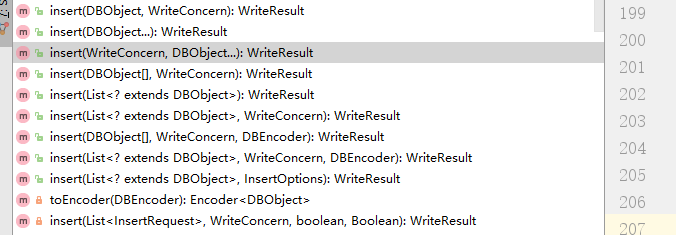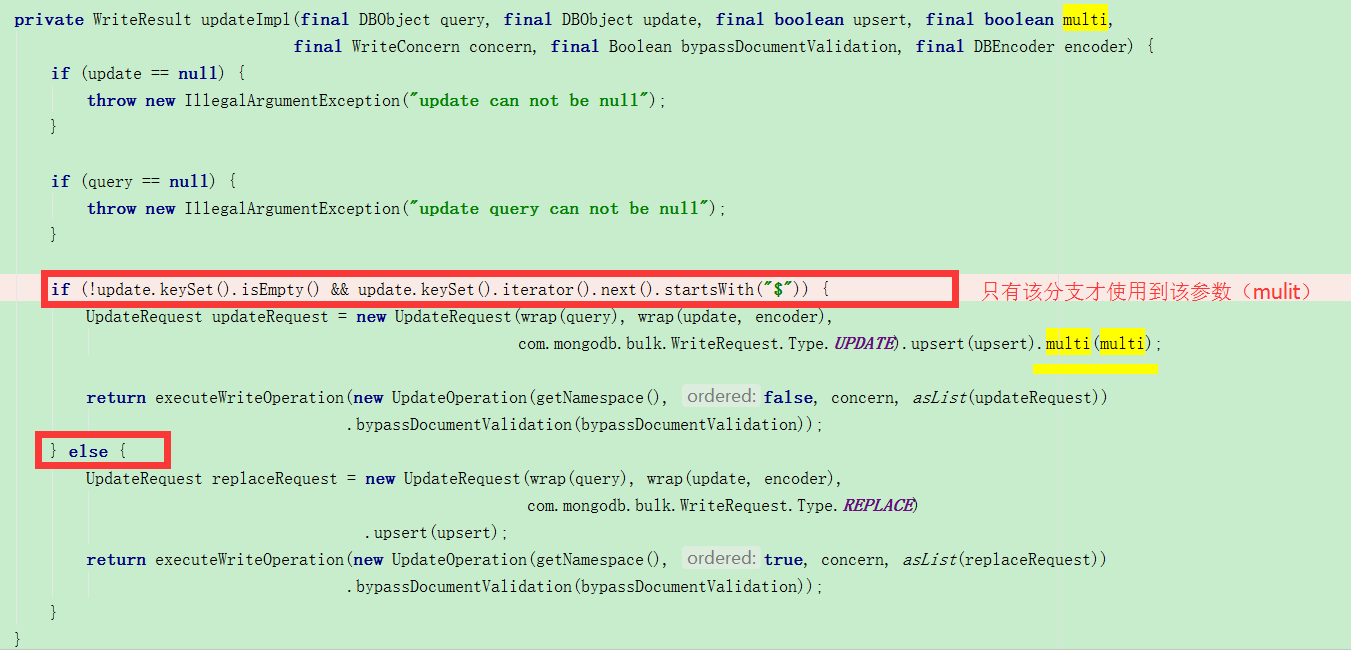===========================================
原文链接: Scala对MongoDB的增删改查操作 转载请注明出处!
===========================================
依赖环境:jdk1.8、Scala 2.12、idea
mongodb Driver:3.1.1。注意,mongo for scala的驱动涉及多个jar(如下图),依赖于mongo-java-driver.jar
这里使用的sbt管理依赖,直接在build.sbt中添加依赖:libraryDependencies += "org.mongodb" %% "casbah" % "3.1.1"(强烈建议使用该方法添加依赖)
一、创建数据库连接
A:不需要用户名和密码直接获取MongoDB。
// 无权限验证连接 def createDatabase(url: String, port: Int, dbName: String): MongoDB = { MongoClient(url, port).getDB(dbName) }
这里需要注意一下,在导入的jar包存在两个MongoClient类,一个来自于mongo-java-driver.jar的com.mongodb.MongoClient,另一个来自于casbah-core_2.12:3.1.1.jar的com.mongodb.casbah.MongoClient.前者是用于java调用,Scala使用后者!!!
因此导入包的时候要注意为:import com.mongodb.casbah.MongoClient

B:通过权限验证进行连接
//验证连接权限 def createDatabase(url: String, port: Int, dbName: String, loginName: String, password: String): MongoDB = { var server = new ServerAddress(url, port) //注意:MongoCredential中有6种创建连接方式,这里使用MONGODB_CR机制进行连接。如果选择错误则会发生权限验证失败 var credentials = MongoCredential.createCredential(loginName, dbName, password.toCharArray) var mongoClient = MongoClient(server, List(credentials)) mongoClient.getDB(dbName) }
这里需要注意的是MongoCredential.createCredential(),在MongoCredential中存在着六种认证机制,这里使用createCredential()进行创建,使用错误则将会验证失败
com.mongodb.MongoSecurityException: Exception authenticating
Caused by: com.mongodb.MongoCommandException: Command failed with error 18: 'auth failed' on server localhost:27017. The full response is { "ok" : 0.0, "errmsg" : "auth failed", "code" : 18, "codeName" : "AuthenticationFailed" }
该方法注释如下:
/**
* Creates a MongoCredential instance with an unspecified mechanism. The client will negotiate the best mechanism
* based on the version of the server that the client is authenticating to. If the server version is 2.8 or higher,
* the driver will authenticate using the SCRAM-SHA-1 mechanism. Otherwise, the driver will authenticate using the
* MONGODB_CR mechanism.
*
* @param userName the user name
* @param database the database where the user is defined
* @param password the user's password
*/

二、数据添加
def testInsert(): Unit = { for (i <- 1 to 100) collection.insert(MongoDBObject("name" -> "Jack%d".format(i), "email" -> "jack%d@sina.com".format(i), "age" -> i % 25, "birthDay" -> new SimpleDateFormat("yyyy-MM-dd").parse("2016-03-25"))) }
这里的collection是在下面创建的:
var collection= createDatabase("localhost", 27017, "mytest", "user", "123456").getCollection("user")
在进行数据插入的时候,如果不存在该collection则会自动创建(这里是user),如果document中不包含“_id”字段则会自动添加该字段。
DBCollection中存在一个save方法,该save方法区别于insert的地方在于当“_id”存在于集合中,save将会进行更新数据,而insert不会进行任何操作
根据需要选择适合的数据插入函数

存储之后数据如下:
{ "_id" : { "$oid" : "592ad4be45aefd09f4867f1e"} , "name" : "Jack86" , "email" : "jack86@sina.com" , "age" : 11 , "birthDay" : { "$date" : "2016-03-24T16:00:00.000Z"}}
{ "_id" : { "$oid" : "592ad4be45aefd09f4867f1f"} , "name" : "Jack87" , "email" : "jack87@sina.com" , "age" : 12 , "birthDay" : { "$date" : "2016-03-24T16:00:00.000Z"}}
{ "_id" : { "$oid" : "592ad4be45aefd09f4867f20"} , "name" : "Jack88" , "email" : "jack88@sina.com" , "age" : 13 , "birthDay" : { "$date" : "2016-03-24T16:00:00.000Z"}}
{ "_id" : { "$oid" : "592ad4be45aefd09f4867f21"} , "name" : "Jack89" , "email" : "jack89@sina.com" , "age" : 14 , "birthDay" : { "$date" : "2016-03-24T16:00:00.000Z"}}
三、数据更新修改
A:更新方式一
def testUpdate(): Unit = { var query = MongoDBObject("name" -> "user1", "email" -> "user1@test.com") var value = MongoDBObject("name" -> "user1", "email" -> "user1@test.com123456") println("=========更新之前============") var query02 = MongoDBObject("name" -> "user1") collection.find(query02).forEach(x => println(x)) // query:根据此条件进行查询 value:把查询出来结果集的第一条数据设置为value collection.update(query,value) println("=========更新之后============") collection.find(query02).forEach(x => println(x)) }
运行结果如下:(注意这里只更新了一条记录,并不是把所有符合结果的数据都进行更新)

B:更新方式二
def testUpdate02(): Unit = { var query = MongoDBObject("name" -> "user1", "email" -> "user1@test.com123456") var value = new BasicDBObject("$set", new BasicDBObject("email", "user1@test.com")) // var value = MongoDBObject("$set",MongoDBObject("name" -> "user1", "email" -> "user1@test.com123")) println("=========更新之前============") var query02 = MongoDBObject("name" -> "user1") collection.find(query02).forEach(x => println(x)) collection.update(query, value,true, true) println("=========更新之后============") collection.find(query02).forEach(x => println(x)) }
注意该方法:collection.update(query, value,true, true)。
第三个参数:when true, inserts a document if no document matches the update query criteria
第四个参数:when true, updates all documents in the collection that match the update query criteria, otherwise only updates one【当该值为true时,则更新所有的结果集数据,不过前提是value必须使用“$XXX”模式进行定义】。源码如下:

四、数据查询(建议看下这篇文章:MongoDB学习笔记(查询))
def testSelect(): Unit ={ println("=========查询所有数据===================") collection.find().forEach(x => println(x)) println("=========查询name = “user1” 同时email=“user1@test.com”===================") collection.find(MongoDBObject("name" -> "user1", "email" -> "user1@test.com")).limit(3).forEach(x => println(x)) // 注意此处不能使用put添加其他查询条件,因为put返回的是HashMap,此处应该使用append进行添加查询条件 // var query = new BasicDBObject("name",new BasicDBObject("$in",("user145","user155"))).put("qty",new BasicDBObject("$in",(25.0,105.0))) 该方法错误 // 查询条件为: (name in ("user145","user155")) && (qty in (25.0,105.0)) println("=========查询 (name in ("user145","user155")) && (qty in (25.0,105.0))===================") var query = new BasicDBObject("name", new BasicDBObject("$in", ("user145", "user155"))).append("qty", new BasicDBObject("$in", (25.0, 105.0))) collection.find(query).forEach(x => println(x)) println("=========查询 start >= 10 && end<= 80 的数据===================") var query02 = new BasicDBObject("start", new BasicDBObject("$gte", 10)).append("end", new BasicDBObject("$lte", 80)) collection.find(query02).forEach(x => println(x)) }
查询结果如下:

五、数据删除
数据删除主要是构建一个查询条件,把符合该条件的所有数据都进行删除
def testDelete(): Unit ={ var query = MongoDBObject("name" -> "user1", "email" -> "user1@test.com") println("=========删除之前============") collection.find(query).forEach(x => println(x)) //该参数只是一个查询条件,符合该条件的所有集合都将被删除。重点在于如何构建query collection.remove(query) println("=========删除之前============") collection.find(query).forEach(x => println(x)) }
执行结果如下:
=========删除之前============
{ "_id" : { "$oid" : "592a0c8345aefd1d404c3ed9"} , "name" : "user1" , "email" : "user1@test.com"}
{ "_id" : { "$oid" : "592a0c8345aefd1d404c3eda"} , "name" : "user1" , "email" : "user1@test.com"}
{ "_id" : { "$oid" : "592a0c9845aefd0dfc2a1e21"} , "name" : "user1" , "email" : "user1@test.com"}
{ "_id" : { "$oid" : "592a0c9845aefd0dfc2a1e23"} , "name" : "user1" , "email" : "user1@test.com"}
{ "_id" : { "$oid" : "592a740f434a43d3b1529d0e"} , "name" : "user1" , "email" : "user1@test.com"}
=========删除之后============
remove方法有如下四种,根据具体情况选取合适的方法:

附测试源码:
package tool import java.text.SimpleDateFormat import java.util import java.util.Date import com.mongodb.casbah.commons.MongoDBObject import com.mongodb.{BasicDBObject, DBCollection, ServerAddress} import com.mongodb.casbah.{MongoClient, MongoCredential, MongoDB} import com.mongodb.client.model.Filters import org.joda.time.DateTime /** * Created with IntelliJ IDEA. * Description: * User: Perkins Zhu * Date: 2017-05-28 * Time: 19:33 */ object MongoTool { def main(args: Array[String]): Unit = { // testInsert // testUpdate02 // testSelect testDelete } def testDelete(): Unit ={ var query = MongoDBObject("name" -> "user1", "email" -> "user1@test.com") println("=========删除之前============") collection.find(query).forEach(x => println(x)) //该参数只是一个查询条件,符合该条件的所有集合都将被删除 collection.remove(query) collection.findAndRemove() println("=========删除之前============") collection.find(query).forEach(x => println(x)) } def testUpdate01(): Unit = { var query = MongoDBObject("name" -> "user1", "email" -> "user1@test.com") var value = MongoDBObject("name" -> "user1", "email" -> "user1@test.com123456") println("=========更新之前============") var query02 = MongoDBObject("name" -> "user1") collection.find(query02).forEach(x => println(x)) // query:根据此条件进行查询 value:把查询出来结果集的第一条数据设置为value collection.update(query,value) println("=========更新之后============") collection.find(query02).forEach(x => println(x)) } def testUpdate02(): Unit = { var query = MongoDBObject("name" -> "user1", "email" -> "user1@test.com123456") var value = new BasicDBObject("$set", new BasicDBObject("email", "user1@test.com")) // var value = MongoDBObject("$set",MongoDBObject("name" -> "user1", "email" -> "user1@test.com123")) println("=========更新之前============") var query02 = MongoDBObject("name" -> "user1") collection.find(query02).forEach(x => println(x)) collection.update(query, value,true, true) println("=========更新之后============") collection.find(query02).forEach(x => println(x)) } def testSelect(): Unit ={ println("=========查询所有数据===================") collection.find().forEach(x => println(x)) println("=========查询name = “user1” 同时email=“user1@test.com”===================") collection.find(MongoDBObject("name" -> "user1", "email" -> "user1@test.com")).limit(3).forEach(x => println(x)) // 注意此处不能使用put添加其他查询条件,因为put返回的是HashMap,此处应该使用append进行添加查询条件 // var query = new BasicDBObject("name",new BasicDBObject("$in",("user145","user155"))).put("qty",new BasicDBObject("$in",(25.0,105.0))) 该方法错误 // 查询条件为: (name in ("user145","user155")) && (qty in (25.0,105.0)) println("=========查询 (name in ("user145","user155")) && (qty in (25.0,105.0))===================") var query = new BasicDBObject("name", new BasicDBObject("$in", ("user145", "user155"))).append("qty", new BasicDBObject("$in", (25.0, 105.0))) collection.find(query).forEach(x => println(x)) println("=========查询 start >= 10 && end<= 80 的数据===================") var query02 = new BasicDBObject("start", new BasicDBObject("$gte", 10)).append("end", new BasicDBObject("$lte", 80)) collection.find(query02).forEach(x => println(x)) } def testInsert(): Unit = { for (i <- 1 to 100) // 注意与saved的区别 collection.insert(MongoDBObject("name" -> "Jack%d".format(i), "email" -> "jack%d@sina.com".format(i), "age" -> i % 25, "birthDay" -> new SimpleDateFormat("yyyy-MM-dd").parse("2016-03-25"))) } var collection = createDatabase("localhost", 27017, "mytest", "user", "123456").getCollection("user") //验证连接权限 def createDatabase(url: String, port: Int, dbName: String, loginName: String, password: String): MongoDB = { var server = new ServerAddress(url, port) //注意:MongoCredential中有6种创建连接方式,这里使用MONGODB_CR机制进行连接。如果选择错误则会发生权限验证失败 var credentials = MongoCredential.createCredential(loginName, dbName, password.toCharArray) var mongoClient = MongoClient(server, List(credentials)) mongoClient.getDB(dbName) } // 无权限验证连接 def createDatabase(url: String, port: Int, dbName: String): MongoDB = { MongoClient(url, port).getDB(dbName) } }
--end